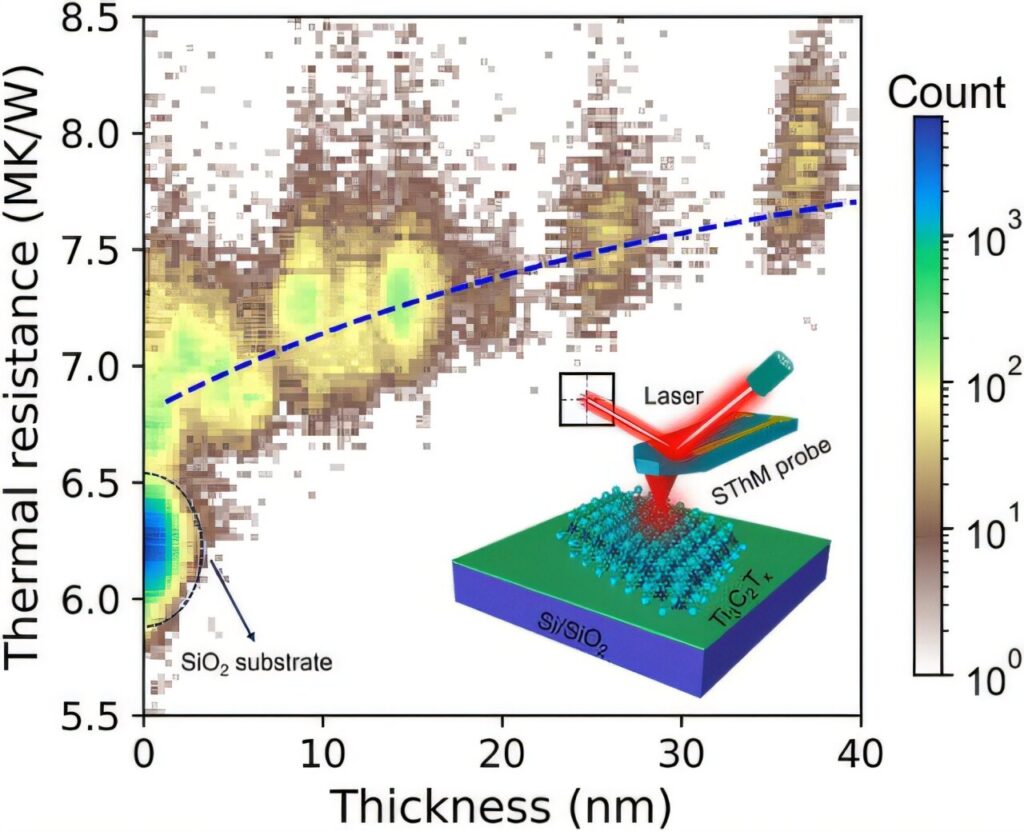Materials that conduct electricity well, like metals, also tend to conduct heat. For instance, a metal spoon left in a hot cup of tea will get hot, while the ceramic mug remains cool. This is because good electrical conductors are usually good heat conductors too.
However, researchers at Drexel University and Université catholique de Louvain (UCLouvain) in Belgium have discovered that MXenes, a type of material known for its excellent electrical conductivity, actually have very low thermal conductivity.
This finding challenges the usual link between electrical and heat conduction. And the discovery could lead to new developments in building materials, performance apparel and energy storage solutions.
An article recently published in the journal ACS Nano, reports that MXenes, a class of two-dimensional materials, originally discovered at Drexel in 2011, demonstrate the rare combination of high electrical conductivity and low thermal conductivity.
While MXene materials have proven exceptional among two-dimensional materials in a number of ways—including their strength, ability to selectively block and trap radiation and filter chemicals—their performance as an ultrathin thermal insulator could be their most promising trait for future applications, according to the research team.
“Thermal insulation of this magnitude, that is also 100 to 1,000 times thinner than a human hair, would simply have been unimaginable until now,” said Yury Gogotsi, Ph.D., distinguished university and Bach professor at Drexel’s College of Engineering, who was a leader of the thermally-insulating MXene development. “This could change the way we insulate buildings and industrial equipment, and make thermal clothing, just to name a few exciting possibilities.”
Gogotsi originally published research and patented MXene films capable of very low heat (infrared) emission as early as 2020. But the mechanisms behind its outstanding thermal insulation were not fully understood until his collaborators from Belgium used a scanning thermal microscopy technique to measure heat transfer—or local thermal transport—on the surface of single flakes of titanium carbide MXene.
A resistor probe, functioning both as a heat source and temperature sensor, scanned the surface of MXene flakes, taking temperature measurements as it made contact with the surface. This produced a map of the heat flow into the MXene sample and the thermal resistance of its surface.
What the map revealed was quite striking: Rather than quickly heating up when touched by the probe, the material held its surface temperature nearly constant for the entirety of the test.
“Surprisingly, the thermal conductivity of the sample was almost one order of magnitude smaller than the value predicted by the laws that govern solid-state physics,” said Pascal Gehring, Ph.D., the lead author of the research from UCLouvian.
“At the same time, the heat loss of the titanium carbide MXene sample is a full two orders of magnitude smaller than common metals, like low-emission gold, aluminum and steel. Which means that it could be an excellent material for thermal isolation and shielding.”
While additional investigation is needed to verify the exact mechanisms involved, the team suggests that the material’s low thermal activity is likely due to its structure. Typically, heat is transported through two primary mechanisms: the movement of electrons and vibrations of the material’s lattice structure, called phonons.
Discover the latest in science, tech, and space with over 100,000 subscribers who rely on Phys.org for daily insights.
Sign up for our free newsletter and get updates on breakthroughs,
innovations, and research that matter—daily or weekly.
In the MXene material, a strong coupling between these two pathways significantly reduces overall heat transport. A similar mechanism is likely at play in the titanium carbide MXene’s low emission and efficient reflection of infrared radiation, which was reported in previous research by the Drexel team.
Gogotsi notes that because of its ability to shield infrared radiation without transferring heat, the material can produce a temperature drop of more than 100°F. This means that with just a spray coating of the material—a possibility suggested by related research recently published in Nature Communications—buildings could be insulated in the winter and would need much less air conditioning in the summer.
“This could be a very exciting development for worldwide energy conservation efforts,” Gogotsi said. “Better insulation for buildings and transportation could result in enormous energy savings and minimize unintended heating of the environment.
“Our preliminary findings already indicate that a thin coating of MXene insulation could perform as well as an inch-thick mineral felt with aluminum insulation currently used in construction. But we are confident that with further development MXene-based thermal insulation can exceed all known materials.”
Other applications for the material could include coating furnaces and other thermal equipment—possibly replacing ceramic insulation and polished stainless-steel casings—insulating ovens, and even forming new protective shielding for aerospace vehicles, the researchers suggest.
The next step for this research will entail testing other varietals of MXenes and examining the insulating ability of MXene coatings on various substrates.


